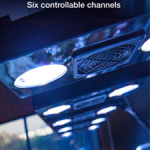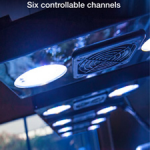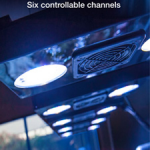EDIT: I have received notice that I was incorrect in using the term Oxygen Redox Potential to describe ORP. Commonly ORP is described as Oxidation Reduction Potential. However, in his book “Water Chemistry for the Marine Aquarium” published in 2005, author John H. Tullock gives an in-depth description of ORP. He describes redox as “…the tendency for redox reactions to occur in a solution. The redox potential of a complex solution such as seawater is the sum of all redox potentials present. Page # 15” Because aquarists using ozone are often attempting to use ORP as a measure of seawater quality, or create better quality water, I describe it as Oxygen Redox Potential, which would be better stated as redox potential. This gives an overall view that in reality we are measuring the sum of all redox potentials in the seawater, to gauge how effectively oxidization is taking place. Though, the term that most applies to aquarium literature is Oxidation Reduction Potential.
While many forms of water purification used in other industries caught on with reef aquarists, ozone never came full circle. Most reef aquarists employ reverse osmosis de-ionization (RODI), carbon filtration and granular ferric oxide (GFO) to maintain water quality. All of these are also used to purify drinking water, or some other commercial application. In commercial water purification ozone use is not uncommon, though for aquarists it’s not something you see on every reef, even those that are featured in “tank of the month” specials or are known worldwide as super systems. Why is this? Ozone has a host of potential benefits, both removing yellowing compounds from water and killing pathogens. Perhaps it’s because there are so many unknowns when implementing ozone. We don’t really know exactly what it does and we don’t totally understand its role in natural seawater. We make an assumption that a higher oxygen redox potential (ORP) equals cleaner water, but even that is up for debate. To make matters worse, ozone carries with it potential risks for both the aquarist and the aquarium. The icing on ozone’s proverbial cake is that it’s both costly and tricky to implement. For those interested in ozone, there are some benefits to implementing it and with some consideration it can be done both successfully and safely.
What is ozone?
 Ozone is an inorganic molecule with the chemical formula OO2, also referred to as tri-oxygen or 03 on many hobbyist grade generators. It’s the same bluish gas found in the ozone layer, protecting planet Earth from the harsh effects of ultraviolet radiation. Ozone has a pungent odor, making a room smell like all surfaces have been wiped down with bleach. Since ozone is a powerful oxidant, it has a variety of consumer and industrial uses. Although, ozone can damage the respiratory tissues and mucous membranes of both plants and animals, making long term exposure (or short term exposure to high volumes) problematic. In industry ozone is used as a disinfectant primarily and also to remove odors and pigments from dyes and water. In water conditioning, ozone is used to both increase clarity and remove pathogens. At high enough levels ozone is a powerful sterilizer making it capable of wiping out every living thing in the aquarium, right down to bacteria and viruses.
Ozone is an inorganic molecule with the chemical formula OO2, also referred to as tri-oxygen or 03 on many hobbyist grade generators. It’s the same bluish gas found in the ozone layer, protecting planet Earth from the harsh effects of ultraviolet radiation. Ozone has a pungent odor, making a room smell like all surfaces have been wiped down with bleach. Since ozone is a powerful oxidant, it has a variety of consumer and industrial uses. Although, ozone can damage the respiratory tissues and mucous membranes of both plants and animals, making long term exposure (or short term exposure to high volumes) problematic. In industry ozone is used as a disinfectant primarily and also to remove odors and pigments from dyes and water. In water conditioning, ozone is used to both increase clarity and remove pathogens. At high enough levels ozone is a powerful sterilizer making it capable of wiping out every living thing in the aquarium, right down to bacteria and viruses.
Why use this in marine aquariums?
 Ozone is used by many aquaculture and fish wholesalers/retailers to control pathogens. Since it’s a powerful sterilizer, ozone is capable of killing parasites during the complex chemical reactions where it enters the aquarium. It is believed that the oxidizing properties of ozone breakdown organic matter within aquarium water, easing the work of the biological filter thus making it more effective. Some aquarists report it enhances skimming, creating a higher production of skim mate or enhancing skim mate with dark, thick organic material. Oddly enough, other aquarists report it causes a complete loss of skim mate, believed to occur by breaking down waste so that the biological filter removes it before it can be skimmed.
Ozone is used by many aquaculture and fish wholesalers/retailers to control pathogens. Since it’s a powerful sterilizer, ozone is capable of killing parasites during the complex chemical reactions where it enters the aquarium. It is believed that the oxidizing properties of ozone breakdown organic matter within aquarium water, easing the work of the biological filter thus making it more effective. Some aquarists report it enhances skimming, creating a higher production of skim mate or enhancing skim mate with dark, thick organic material. Oddly enough, other aquarists report it causes a complete loss of skim mate, believed to occur by breaking down waste so that the biological filter removes it before it can be skimmed.
Ozone quickly turns ammonia into nitrate and the most widely reported effect is removing discoloration from water and making it crystal clear. A variety of experiments have taken marine tank water which had a noticeable yellow tinge and placed it under filtration with ozone. After a short time period the water was crystal clear appearing as if it had just been made. Like so many things implemented on marine aquariums, ozone’s goal is to make water cleaner. Some aquarists report it has lowered nitrates or phosphates and many who use ozone swear by its perceived benefits. As I said earlier, much about ozone’s effect is largely unknown and assumed because of its relationship to ORP.
ORP?
 Oxygen redox potential is a tricky measurement and like ozone, we don’t fully understand exactly what it tells us about our tank’s water quality. Even scientists don’t fully understand ORP’s relationship to water quality, nor its effect on natural or synthetic seawater. At the core, ORP is a measure of how effective oxidization is taking place within the water. Low ORP values can diminish the amount of oxygen available to animals, while also decreasing the ability of bacteria to assimilate organics. The more organic molecules within a tank, the lower the ORP, leading many aquarists to believe ORP is actually a measurement of water’s general purity. It’s a common rule of thumb in the hobby that an ORP value below 200mv signals a high organic load, essentially dirty water. Some aquarists measure ORP, even though they don’t implement ozone. To them, a sudden fall in the tank’s ORP is a signal that something is wrong, perhaps a sudden build-up of organic material from dead livestock.
Oxygen redox potential is a tricky measurement and like ozone, we don’t fully understand exactly what it tells us about our tank’s water quality. Even scientists don’t fully understand ORP’s relationship to water quality, nor its effect on natural or synthetic seawater. At the core, ORP is a measure of how effective oxidization is taking place within the water. Low ORP values can diminish the amount of oxygen available to animals, while also decreasing the ability of bacteria to assimilate organics. The more organic molecules within a tank, the lower the ORP, leading many aquarists to believe ORP is actually a measurement of water’s general purity. It’s a common rule of thumb in the hobby that an ORP value below 200mv signals a high organic load, essentially dirty water. Some aquarists measure ORP, even though they don’t implement ozone. To them, a sudden fall in the tank’s ORP is a signal that something is wrong, perhaps a sudden build-up of organic material from dead livestock.
The problem is two-fold, in that successful marine aquariums have been run without ozone with ORP values that should indicate an aquarium with poor water quality. ORP changes quite often, with simply running a protein skimmer or adding circulation to the aquarium raising ORP without the addition of an oxidizer like ozone. Some experts say ozone is a complete waste of time and money, carrying far too many inherent risks for aquarists to consider. Others claim it’s a highly effective way to raise the general water quality in a marine tank, while also effectively eradicating bacteria and parasites.
How is ozone implemented?
 Ozone’s reaction time is fast, meaning that it cannot be stored in a cylinder such as CO2 or pure oxygen. The gas must be created on-site, right at the point where it’s being used. Ozone generators are available to hobbyists and work by using an electronic coil to break oxygen molecules apart. As the molecules reassemble, some bind together forming 03, tri-oxygen otherwise known as ozone. The easiest to implement generators actually serve as both an air-pump and ozone generator, removing the need for an air pump to move air through the ozone generator.
Ozone’s reaction time is fast, meaning that it cannot be stored in a cylinder such as CO2 or pure oxygen. The gas must be created on-site, right at the point where it’s being used. Ozone generators are available to hobbyists and work by using an electronic coil to break oxygen molecules apart. As the molecules reassemble, some bind together forming 03, tri-oxygen otherwise known as ozone. The easiest to implement generators actually serve as both an air-pump and ozone generator, removing the need for an air pump to move air through the ozone generator.
The MOST important thing about ozone use is that anywhere that ozone is exhausted, be it water or air, must be filtered through carbon. Carbon is highly effective at removing residual ozone from water or air. Since a protein skimmer often doubles as ozone’s reaction chamber, you must cover the air holes on your skimmer’s collection cup with carbon or set a bag of carbon on the collection cup where air exhausts. The same can be said about the skimmer’s exhaust into the aquarium, it must be filtered with carbon as well. Since it’s harmful to animals (including humans) you don’t want any ozone entering the aquarium or fish room. To accomplish this I use carbon pads meant for air purifiers, cut to the size of my skimmer’s collection cup cap and taped on with duct tape. Doing this guarantees the residual ozone that may leak through those holes is filtered through carbon and removed before entering the room.
On the skimmer output side, it’s very easy to zip-tie a filter bag full of carbon to the skimmer exhaust ensuring that ozone is removed from any returning water. Failure to do this can result in a total wipe out of all livestock in the tank and serious health risks for anyone in the fish room.
Ozone use actually starts with an air dryer, a simple reactor filled with desiccant. The desiccant discolors over time when it’s exhausted and needs replaced. The air dryer removes moisture from air entering the ozone generator as moisture can cause the formation of nitric acid as oxygen molecules reassemble into ozone. Nitric acid is very hard on aquarium equipment and can lower the ph of your tank’s water. Like carbon, air drying is a vital step needed to prevent serious problems. If your unit requires an air pump, the pump would push air into the air dryer, if your unit doesn’t the air dryer’s output runs into the ozone generator.
Ozone generators are fairly simple devices, usually just containing a knob that controls how many mg per hour the generator will create. Most ozone generators recommend between 5-15 mg of ozone per 25 gallons of water per hour. While this offers some control over how much gas is being created, it doesn’t monitor the effect of that gas on the tank. To do this and to ensure you don’t overdose your system with ozone, an ORP controller is required. Failure to use an ORP controller is asking for major problems. ORP controllers are simple devices that use a probe to measure ORP. They have a setting which will kick an ozone generator off if ozone rises beyond a specified point, or on if it goes below. Remember that ORP is NOT a measurement of ozone within the tank’s water, simply a report of the redox potential of oxygen which may give clues about how much organic waste is within the water. There are test kits that check your water for ozone and this should be done periodically to make sure none is entering the system.
Now that the reaction is occurring, you need a reaction chamber. Since an ozone reaction chamber is somewhere that ozone and water violently mix, a protein skimmer is an ideal choice. Ozone reactors are available, but these are costly and ineffective. Exiting the ozone generator, tubing is run to the protein skimmer’s air intake, usually the open port on the air silencer. This injects ozone gas into the skimmer, allowing it to react with aquarium water which is then returned the tank, filtered through carbon removing any residual ozone.
A few things to consider. First, if your skimmer is not ozone rated plastic then overtime ozone will degrade the plastic, eventually cracking it and causing it to leak. This can take years and according to some articles regarding ozone’s effect on various materials, acrylic (a common material used to build skimmers) has a better than average resistance to ozone. If ozone rated tubing isn’t used, the tubing with simply fall apart quickly between the generator and skimmer. Ozone use is a slow and steady race and no two tanks are alike in their reaction to ozone. I learned this the hard way, setting my ORP controller for 450mv and allowing the ozone generator to blast the tank with ozone. Within several hours I had a tang lying on the tank bottom struggling to breathe. Luckily once ozone was reduced he came around, but it’s vital to move slow. Most aquarists using ozone shoot for an ORP value of 300-450mv. I shoot for around 300mv to be conservative.
Before turning on an ozone generator, you must get a sold read on your tank’s natural ORP. When I began using ozone my tank’s ORP was just shy of 200. Set the generator at the lowest setting, increasing your ORP by 25mv per-day. Once you notice that the ORP has settled out, say you have your ORP controller set at 300 but the tank’s ORP won’t go above 250, then you can increase the setting on your generator to create more ozone. This process takes days, not hours. Your first line of defense is the ozone generator’s control knob, not the ORP controller. You can be pumping too much ozone into a skimmer and still not be at the desired ORP setting.
Once you have reached your desired ORP, the controller does most of the work, switching the generator off when ORP falls within the pre-set limits. If you can smell the bleach like odor of ozone you are either using far too much or not properly filtering ozone from the air or tank. That smell should not be taken lightly and the ozone generator show be switched off until the area of exhaust is determined and corrected.
My personal view on ozone:
 For me ozone can potentially enhance skimming which is one of our most effective filtration tools as marine aquarists. I use ozone on my reef aquarium (not my fish only tanks) as a means to maintain water clarity and hopefully remove some organic waste. It also acts as a way to kill off some bacteria and parasites, though like a UV sterilizer it is neither a treatment for, nor preventative of parasite infection. Since it’s entirely possible for parasites to remain in the tank, never passing through the skimmer thus reacting with the gas, if your tank is having parasitic problems ozone will not cure them.
For me ozone can potentially enhance skimming which is one of our most effective filtration tools as marine aquarists. I use ozone on my reef aquarium (not my fish only tanks) as a means to maintain water clarity and hopefully remove some organic waste. It also acts as a way to kill off some bacteria and parasites, though like a UV sterilizer it is neither a treatment for, nor preventative of parasite infection. Since it’s entirely possible for parasites to remain in the tank, never passing through the skimmer thus reacting with the gas, if your tank is having parasitic problems ozone will not cure them.
There is enough evidence in favor of the idea that ORP is a measurement of overall water quality that I decided to implement ozone. The major benefit you notice very quickly is that your water is crystal clear. This can of course be accomplished with carbon filtration, but carbon requires monthly changing and I find the clarity achieved with ozone far exceeds that achieved with carbon alone.











0 Comments